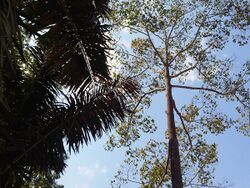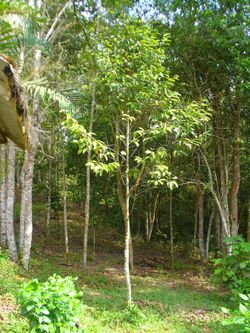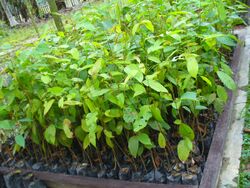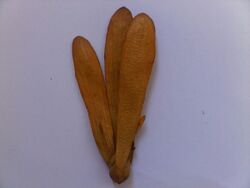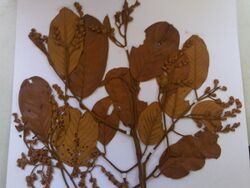Biology:Shorea leprosula
| Shorea leprosula | |
|---|---|
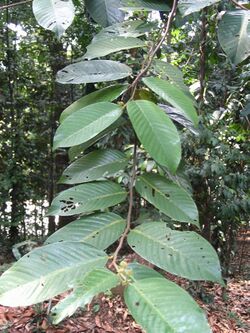
| |
| Scientific classification | |
| Kingdom: | Plantae |
| Clade: | Tracheophytes |
| Clade: | Angiosperms |
| Clade: | Eudicots |
| Clade: | Rosids |
| Order: | Malvales |
| Family: | Dipterocarpaceae |
| Genus: | Shorea |
| Species: | S. leprosula
|
| Binomial name | |
| Shorea leprosula Miq.[1]
| |
Shorea leprosula (called, along with some other species in the genus Shorea, light red meranti) is a species of tree in the family Dipterocarpaceae. It is native to Sumatra, Borneo, Peninsular Malaysia, Java, and Thailand.[1]
Description
Trees reach up to 60 meter tall and 100 cm in diameter. Bark is greyish brown, shallowly fissured, and V-shaped. Outer bark is dull purple brown, hard, brittle. Inner bark is fibrous, dull brown or yellowish brown grading to pale at the cambium. Sapwood is pale or cream, resinous, while heartwood is dark red or light red brown. Its leaves are elliptic to ovate, 8–14 cm long, 3.5 to 5.5 cm wide. They are cream scaly, thinly leathery. Leaf base is obtuse or broadly cuneate, apex is acuminate, up to 8 mm long. Secondary vein comes in 12–15 pairs, and are slender, curved towards margin, set at 40 to 550. Tertiary veins are densely ladder-like, slender and obscure except in young trees. Stipules are 10 mm long, 35 mm wide, with short scars. They are horizontal, obscure, oblong to broadly hastate, obtuse, fugacious, and fall off early/ Fruit pedicel reaches 2 mm long. Calyx is sparsely pubescent, with 3 longer lobes up to 10 cm long, approximately 2 cm wide. They are spatulate, obtuse, approximate 5 mm broad above the 8 by 6 mm thickened elliptic, shallowly saccate base. Two shorter lobes are up to 5.5 cm long, approximately 0.3 cm wide, unequal, and similarly saccate at base.[2][3][4]
Distribution
They inhabit the Southeast Asia rain forest; from Peninsular Thailand throughout the Malay Peninsula (excluding the seasonal area), Sumatera, Bangka, Belitung, and Borneo.
Ecology
Shorea leprosula is one of the fastest growing Dipterocarp species up to about its twentieth year, when it is surpassed by other Dipterocarps. S. leprosula can grow in a variety of site conditions with flat topography. It is found throughout hilly areas, frequently on well-drained soil, on deep clay soils or swampy soil in the mixed Dipterocarp forest of lowlands and hill up to 700 meter above sea level, but it is a strongly light-demanding species.[5][6][7][8]
One of the key successes for S. leprosula is light control. Light control should correspond to the light requirements of a species during its growing stages. Planting methods should reflect site conditions and growth characteristics of the species. S. leprosula is a light-demanding species at the early stage, 60 to 73% (relative light intensity) for seedlings and 74 to 100% for saplings.[5][9]
Vernacular names
The trade name for S. leprosula is known as red meranti or meranti merah. In Brunai and Sawarak: it is called meranti tembaga, perawan lop. In Malaya and Sumatra it is known as meranti betul, meranti bunga, meranti lempong, meranti tamak, meranti hijau, meranti sabut, merati kait, meranti sepang (Palembang). In Kutai it is called lampong, banti, barit, bekunsu, belaitok, belito, or damar. On Sampit: lentang. On Dayang Benuag: Mengkorau.[10]
Propagation
S. leprosula can be propagated by seeds, cuttings and wildlings.
Uses
The wood is used for construction.
References
- ↑ 1.0 1.1 1.2 Pooma, R.; Newman, M.F. (2017). "Shorea leprosula". IUCN Red List of Threatened Species 2017: e.T33123A2833148. doi:10.2305/IUCN.UK.2017-3.RLTS.T33123A2833148.en. https://www.iucnredlist.org/species/33123/2833148. Retrieved 16 November 2021.
- ↑ Keβler, P.J.A. and Sadiyasa, K., 1994. Trees of the Balikpapan-Samarinda Area, East Kalimantan, Indonesia. A manual to 280 selected species. Tropenbos series 7. The Tropenbos Foundation, Wageningen, the Netherlands. 446.pp
- ↑ Ashton, P.S., 1982. Diptrocarpaceae. In: Flora Malesiana Series I (sec. Mutica) Vol. 9 (2), 540–541
- ↑ Newman, M.F, Burgess, P.F., Whitmore, T.C., 2000. Manuals of Dipterocarps for Foresters: Borneo island light hardwoods. CIFOR and Royal Botanical Garden Eidinburgh. 275 pp.
- ↑ 5.0 5.1 Aldrianto, P., 2002. Dipterocarpaceae: Forest Fire and Forest Recovery. Thesis Wageningen University, The Netherlands. 214 pp
- ↑ Meijer, W. and Wood, G.H.S., 1964. Dipterocarps of Sabah. Pp. 110-112. Sabah Forest Record No. 5. Forest Departement Sabah. Sandakan. 344.pp
- ↑ Yasman, I., 1995. Dipterocarpaceae: Tree-Mycorrhizae-Seedling connection. PhD thesis, Wageningen Agriculture University, the Netherlands. 193 pp
- ↑ Omon, R.M., 2002. Dipterocarpaceae: Shorea leprosula Miq. Cuttings, Mycorrhizae and Nutrients. PhD thesis, Wageningen University, the Netherlands. 144 pp
- ↑ Ishak Yassir dan Yuniar Mytikauji. 2008. Pengaruh Penyiapan Lahan Terhadap Pertumbuhan Shorea Leprosula Miq., dan Shorea balangeran (Korth) Burck pada Lahan alang-alang di Samboja, Kalimantan Timur (Effect of land preparation on the growth of Shorea leprosula Miq., and Shorea balangeran (Korth) Burck on alang-alang areas in Samboja - East Kalimantan). Jurnal Penelitian Dipterokarpa. Balai Besar Diptercarpaceae Samarinda. Vol.I No. 1
- ↑ Ashton, P.S., 1982. Diptrocarpaceae. In: Flora Malesiana Series I (sec. Mutica) Vol. 9 (2), 540-541
Wikidata ☰ Q3017429 entry
 |

